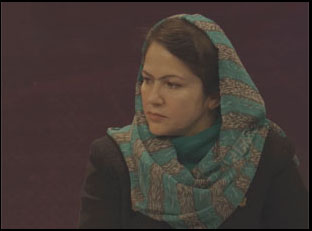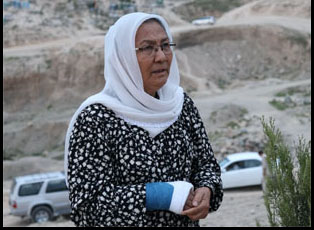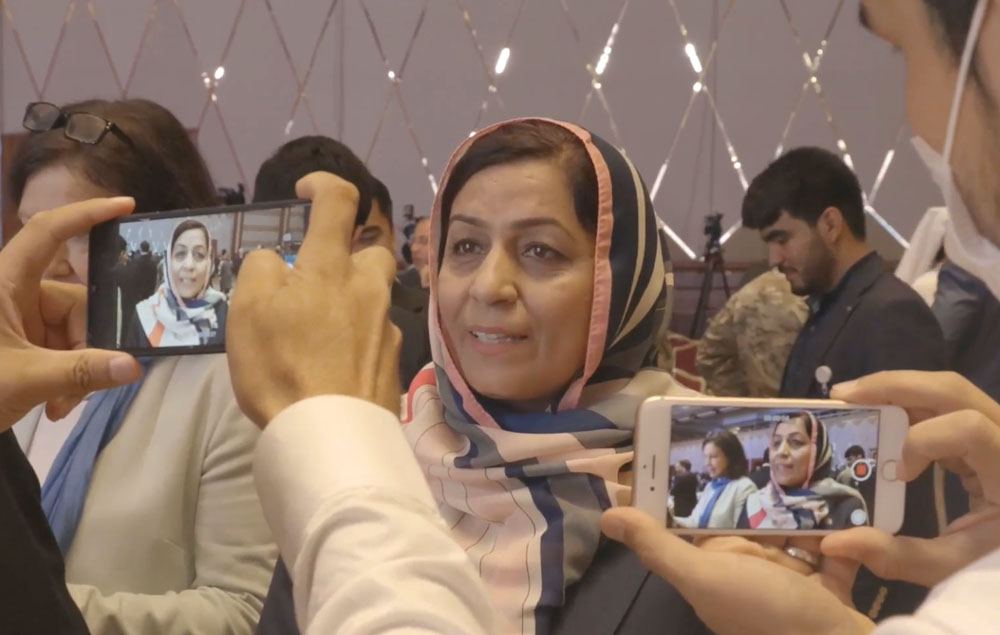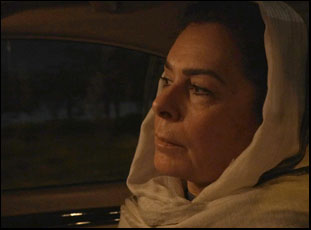Roya Sadat doesn’t waste any time in “The Sharp Edge of Peace” showing how dire the situation is in Afghanistan in the fall of 2020 when the Afghan Government and the Taliban had been set to enter peace talks, prompted by signals that the U.S. would withdraw troops that had been a presence in the country since 2001. Inside a hospital, the director has bedside footage of Fawzia Koofi, a member of the Afghan parliament, who lies injured when one of the threats that’s come to her after being appointed to the delegation that will meet with the Taliban finally comes to pass. However, if anything the attack has only strengthened Koofi’s steely resolve and after introducing three other of Kofi’s fellow female delegates Fatima Gailani, Habiba Sarabi and Sharifa Zumati, Sadat shows patience in unveiling a timeline as devastating as any image she could capture with her camera, outlining a rollback in women’s rights that began in 1979 when the Soviet Union invaded Afghanistan and rural areas became enclaves for the ultra-religious mujahideen who would come to rule the country after the Soviets left and have since had their legacy extended by the Taliban.
“After the 11th of September, attention was on Afghanistan, but Afghanistan comes with a long history, especially for women’s rights,” says Sadat, who notes in the timeline as many strides towards equality that the country took in the years leading up to the invasion, such as the appointment of the country’s first female government minister only five years prior, as all the restrictions that were put in place during the years that followed. “It’s about more than 40 years that we are in the war and before that, women had a normal life in terms of education and women’s rights. But during these 40 years, there were many changes, and [women were] the biggest victims from all of these changes, so we thought how can people understand that when they see the women in Afghanistan right now, [after] the Taliban forced them to put on the burqa and cover their faces, and banned [them from] the schools.”
To see the totality of it in quick succession sticks with you in a way most title cards do not and reflect how in spite of the knowledge that the peace talks of 2020 ultimately failed for reasons that “The Sharp Edge of Peace” brings into focus, the mere fact that Koofi, Gailani, Sarabi and Zumati successfully asserted their place at the bargaining table as part of the Afghan government seems like a step towards progress. As Sadat chronicles, negotiations for the women hardly started in Qatar where the peace talks ultimately took place, gathering feedback from across Afghanistan on what issues should be considered as part of the establishment of a post-war government and doing diplomatic work outside of the scope of the talks once in Doha when the Taliban won’t engage with them. The director, who once saw her uncle refuse to enter her home upon her decision to make films in the early 2000s, shows that when there’s a will, there’s a way as the female contingent of the delegation refuse to let stalled talks get in the way of advancing the cause of women’s rights as the assembly of important international players provides a unique opportunity that the women intend to make the most of.
The same can be said for Sadat, who never lets one think that there was any difficulty accessing such sensitive negotiations with all she ends up capturing in “The Sharp Edge of Peace,” yet as she explained on the eve of the film’s premiere at Hot Docs, that was the only way in which it was far from the truth and spoke of the importance of keeping women’s issues high on the agenda and how despite all odds she managed to be at the right place at the right time.
This film [has been in the works for] about four years. I’ve been working in cinema more than 20 years, and all my movies have been about women, with fiction movies and documentaries, so I received a call from Leslie Thomas, an independent film producer and director from MIRA Studio when the [Afghan] government announced the peace talks, and there were four women as part of negotiation team from the Republic with the Taliban. It it was the first time in the history of Afghanistan that women are part of this really important dialogue and they were going to define their rights and their values in front of the Taliban. These talks were very, very important and unique in the world and and she said, “What do you think if we started to make a documentary about this?”
I accepted [immediately] and I didn’t ask what about our production possibility [was], but I understood how it would be a challenge to make a documentary about the peace process because it was sensitive. Not only the Taliban doesn’t like it, but even the Republic government wasn’t comfortable with the documentary team and also, there’s a security situation, so it was very difficult to get access for our characters, but we’re following them now we have this movie coming out in a really critical moment for Afghanistan, especially for women.
The access ends up being extraordinary, really from the opening scene where you show how serious the threat is against these peace talks inside a hospital. How was it achieved?
Unfortunately, this attack happened suddenly for Fawzia Koofi, one of our characters, and we tried our best to enter to that hospital, but that was military hospital that’s totally banned for media and for cameras [in general]. We were facing many challenges [in general] because the four women, who are very known women and activists in Afghanistan, had an agreement with the peace negotiation team that they should not talking a lot with the media. [But for that opening scene] I found a woman in the parliament who understood that I wanted to visit Fawzia Koofi, and I asked her, “If you just put my mobile inside of your bag and we pass the police checkpoint of the hospital, I will film with my mobile,” so she helped me, and I got inside [the hospital] with her car, and I’m filming that scene with my mobile.
And in terms of technique for this documentary [generally], I thought [at first], “Okay, maybe we can build very good lighting and setup, for [sit-down interviews], but unfortunately, it wasn’t possible. Sometimes it looks like you are filming from the first line of the war because there were many attacks and bomb blasts for women rights activists, for artists, for filmmakers, for media, for journalists. There was a lot of pressure from the Taliban, and people didn’t understand what’s happening. They were just walking on the street, and they see one car was bombed. Due of the security situation, [we were told] it’s much better you come [to the peace talks] with one or two when we had planned for a team of six and we were facing the same situation when we decided to go in Doha to follow up. That time, they accepted only two people, me and my husband, who’s a co-producer and a cinematographer. But we needed two cameras, so it was my first time operating a camera and it was difficult to think technically how we keep the structure [from earlier in the film], but it was important for me that we try our best to bring out the subject that we were following because I didn’t have other choice. It was like you’re making film in the first line of the war.

When the peace talks started, we were all full of hope, thinking, “The reality of Afghan people is different than what the Taliban is thinking for the government and for society. but at least these peace talks maybe will result in peace.” And in the heart of history, you see how characters, change due to the situation. Like the first trip to Doha, [our subjects are] happy, thinking they’re part of this sensible [quorum]. But unfortunately, when they entered Doha, they see the situation and that the Taliban doesn’t have interest to come to the peace talks and because [ultimately] they have negotiations with United States, they don’t need to talk with Afghan people.
We were thinking [originally] that maybe [this process would] take some days, but then it’s a long time and when they came back [after talks broke off], the morale was totally different and the second time when [the Afghan negotiation team] went, you see the changes. When we were leaving with our characters, we understood that maybe something happening because we saw the reality of the situation. The government would only allow media to participate in only the opening ceremony for the peace talks. But once we were in Doha, I thought we are not coming from any TV or newspaper to just write about the opening. We want to be with our characters, even they didn’t allow us to go inside of the negotiation. It was important to be with our characters, and it’s a really long story how we entered — they brought the peace negotiation team from the hotels where there was the opening ceremony with media, and then for the next day, they said to all media, “You cannot enter [this] hotel [where] the peace talks are going to start. If you want to the interview some of the negotiation [team], you can talk with them at another location.”
The media was totally banned from the peace dialogue, but we went with our camera and we didn’t enter from the lobby because there was some journalists without camera. They were waiting for the negotiation team to talk with them, but we went every day from the parking [lot] and inside of the hotel to see our characters and we got this permission by finding our friends. In 2008, my sister Alka won an award from Al Jazeera and the Doha Film Institute, and we were in contact with women who know some people in Doha Film Institute and they [expressed to people involved in the peace talks that] we are independent filmmakers and we are just following this for women, so finally we got to enter to that hotel.

From the beginning [of filming] until the post-production, you see how the situation [was always] changing and it continues to impact our lives. But I’m happy that we have this film right now as a strong witness. People should watch this without any judgment, especially who are wondering about the future of this war and the future of women in politics. Sometimes I thought about what was possible if we have our women in politics, so I encourage people, especially the women who are active in women’s rights and human rights, to watch this documentary.
“The Sharp Edge of Peace” will screen again at Hot Docs on April 28th at 11 am at TIFF Lightbox 3.





